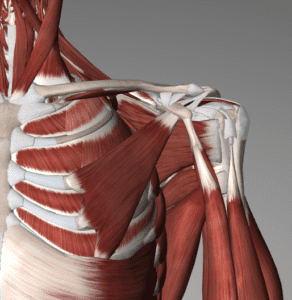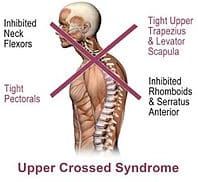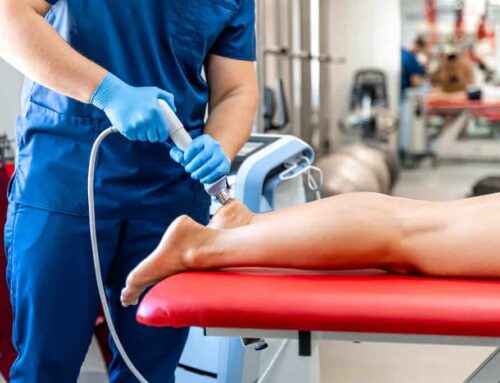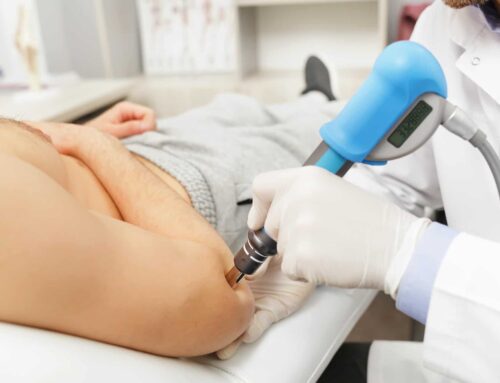Do you ever feel like your shoulders are just pulling you into a slouch? There’s one specific muscle – the pec minor – that may be contributing to this, as well as pain in the shoulders, head and neck! Read on to find out more about pec minor tightness and:
- The role of the pec minor
- The relationship of this muscle to:
- Shoulder pain
- Neck pain
- Headaches
The Pectoralis Minor
The pec minor originates from the ribs and attaches to the front of the shoulder blade. Because of these attachments, the muscle has a big effect on the position of the shoulder blade. Due to the slumped posture that we are very familiar with in modern society (thanks, computers/phones/the internet), the pec minor is vulnerable to getting tight and shortened over time. As pec minor tightness gets worse, the shoulder blade is pulled and tipped forward. This new shoulder blade position is what leads to a potential cascade of problems.
Restrictions in one part of the body can lead to dysfunction at other, distant areas of the body. This effect is known as regional interdependence and is the reason why pec minor tightness can cause pain in the shoulders, neck, and even headaches. You can also see this concept demonstrated when tight hip flexors cause lower back pain when standing, or sciatica.
Pec Minor Tightness and its Relationship to shoulder pain
A tight pec minor can result in the shoulder blade being tipped forward and pulled toward the side of the body. When the shoulder blade is in a suboptimal position, moving the arm overhead becomes difficult. The shoulder blade normally rotates upwards as the arm moves overhead, in order to keep the shoulder joint properly aligned. If it starts in an abnormal position, this upward rotation is more difficult and ultimately stops short, resulting in less motion for overhead reaching or overhead lifting. When this occurs, the soft tissue structures around the shoulder are much more likely to be pinched between the shoulder blade and the upper arm. This pinching is sometimes termed ‘impingement’ and could result in pain over time.
Relationship to neck pain
The rounded shoulder position caused by tightness in the pec minor can also have an impact on the upper half of the spine. As the shoulder blades are pulled forward, the upper thoracic spine may demonstrate an increased forward curve. This causes the neck to extend in order to keep the head pointed forward (upper crossed syndrome). Essentially, the person is put into a position similar to constantly looking up. This posture puts a lot of strain on the joints in the neck, and also leads to tightening of the upper trapezius muscles. This can lead to further neck extension and more joint stress. Eventually the constant stress on the structures in the neck may lead to irritation and pain.
muscleimbalancesyndromes.com
Relationship to headaches
Pec minor tightness has a more indirect relationship to headaches than to pain at the neck or shoulders, but the connection is still very much there. Headaches can arise from stress on joints and muscles in the neck, due to pinching of small nerves that run from the upper neck into the head. The upper crossed posture that is, at least partially, brought on by pec minor tightness leads to compression of these small nerves and resultant headaches.
Regular shoulder mobility exercises and being aware of your posture throughout the day is the best way to avoid falling victim to any of these conditions! Without the proper mobility and strength in the shoulder muscles these problems can worsen over time.
If you’ve been trying to address your pecs and just are not getting the results you want, contact us. We help people get back to doing the things that they love each and every day!
Blog image: https://acornhealth.org.uk/upper-crossed-syndrome-how-poor-posture-causes-pain/





